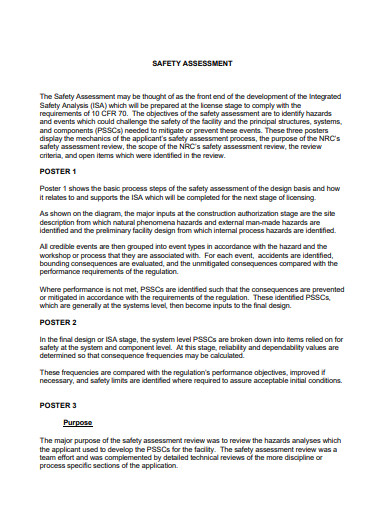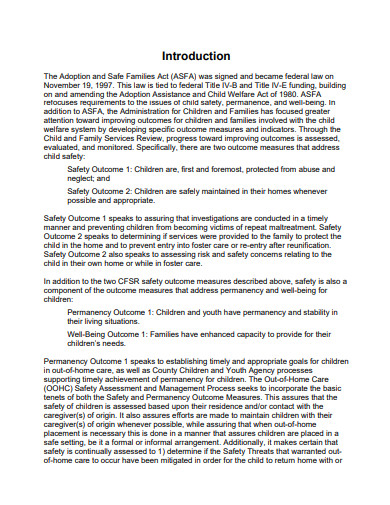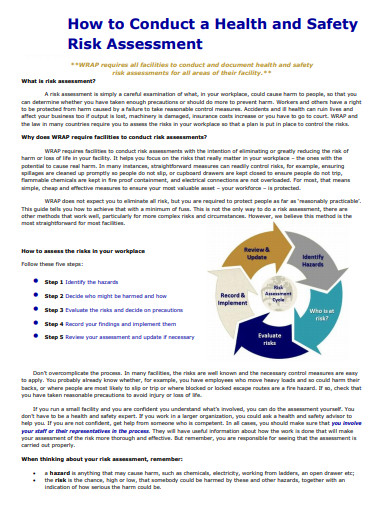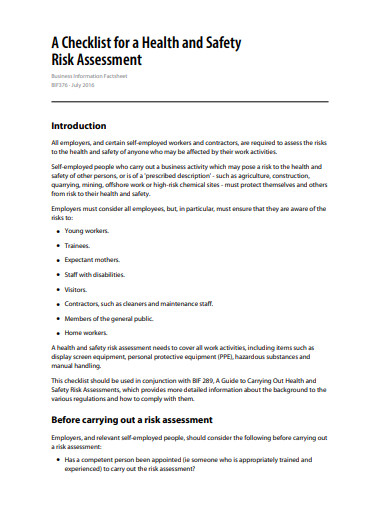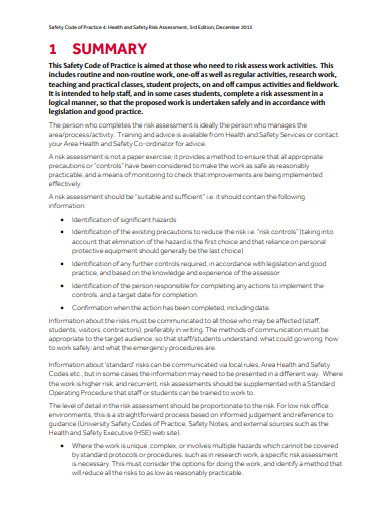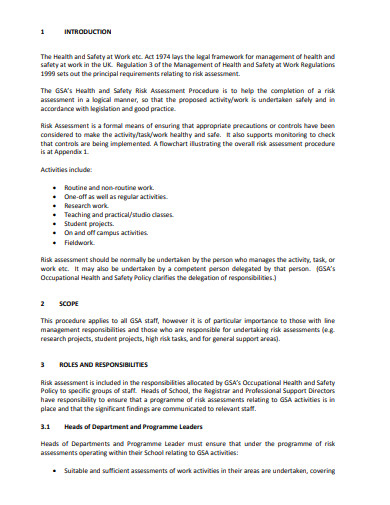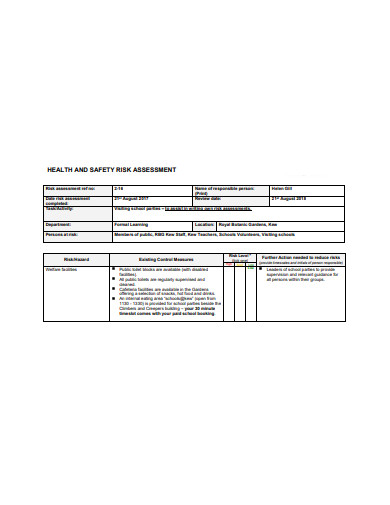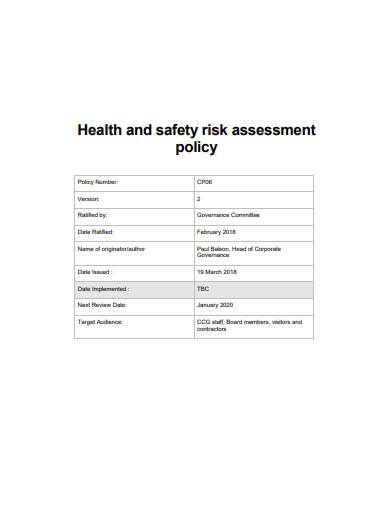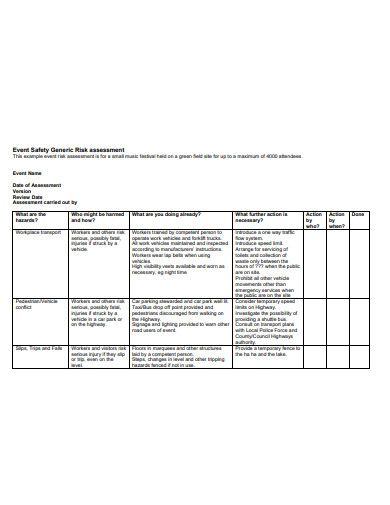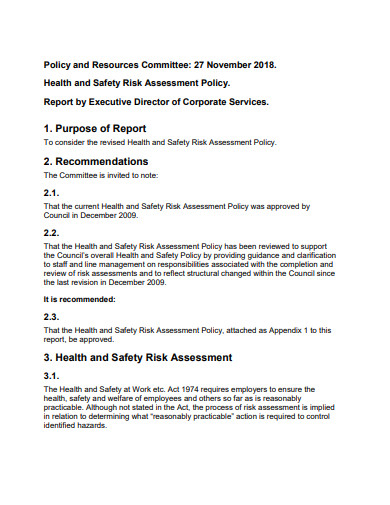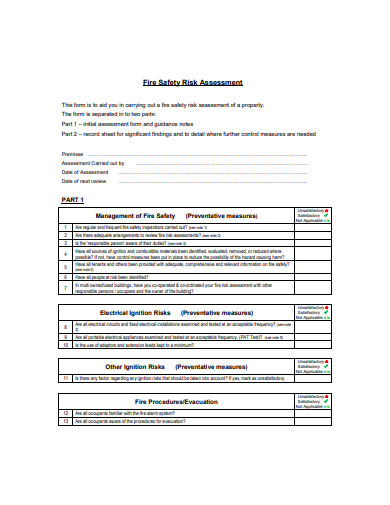12+ Safety Assessment Examples to Download
It is always preferable to be safe than to be sorry. Everywhere we go, we may encounter possible risks in the streets, at school, in the workplace or even at home. There are possible hazards that may lead to causing harm may it be intentional or unintentional. So, it would be better to be prepared by securing a safety or risk assessment that would help us understand the risks to health and safety.
12+ Safety Assessment Examples
1. Safety Assessment Example
2. Safety Assessment and Management Process
3. Health and Safety Risk Assessment
4. Safety Risk Assessment Example
5. Electrical Safety Risk Assessment
6. Health and Safety Risk Assessment Format
7. Sample Health and Safety Risk Assessment
8. Health and Safety Risk Assessment Procedure
9. Basic Health and Safety Risk Assessment
10. Health and Safety Risk Assessment Policy
11. Event Safety Generic Risk Assessment
12. Health and Safety Risk Assessment Policy Format
13. Fire Safety Risk Assessment Format
What is a Safety Assessment?
A safety risk assessment is designed to provide organized details of the hazards, the risks that are associated with the hazards and the strategies that need to be done to reduce the risks and the possible consequences it might bring. A state implemented a certain regulation containing the duties and the type of hazards. It is called the Health and Safety at Work Regulations 2016. These regulations were mandated to observe safety against the major hazards especially in the workplace. It is made under sections 24(1)(m), 211, 212, 213, 215 and 218 of the Health and Safety at Work Act 2015.
What are the Five Steps to Risk Assessment?
1. Identify all the possible hazards
This is one common classification of hazards:
- Physical: lifting, awkward postures, slips and trips, noise, dust, machinery, computer equipment, etc.
- Mental: excess workload, long hours, working with high-need clients, bullying, etc. These are also called ‘psychosocial’ hazards, affecting mental health and occurring within working relationships.
- Chemical: asbestos, cleaning fluids, aerosols, etc.
- Biological: including tuberculosis, hepatitis and other infectious diseases faced by healthcare workers, home care staff and other healthcare professionals.
worksmart.org.uk
2. Identify who could possibly be at risk and how are they going to be at risk.
For example:
Before a flight, passengers are not allowed to bring with them hazardous substances like pesticides, perfumes, and other items that can be in a high pressure when an aircraft obtains a high-altitude flight. It can pose a risk in the entire flight operation, to the crews and to the passengers as well.
Another example would be:
“The scope of the safety assessment review consisted of reviewing the applicant’s analyses of natural phenomena such as seismic events, floods, and high winds as well as external manmade events such as potential industrial explosions, chemical releases, or aircraft hazards; and process hazards. The evaluation of process hazards required an evaluation of facility worker consequences, public and site worker consequences, environmental consequences, and the means for preventing or mitigating these consequences.”
www.nrc.gov
3. Determine how to reduce the risk.
Determine whether a certain hazard is classified as low risk, medium risk or high risk. Provide the possible actions needed to be taken in order to reduce the risk of the respective hazards.
4. Record the findings of your assessment.
This shows the proof that the assessment is working and it can be further applied. It can be updated annually depending on the policy of the institution or company.
5. Ensure that the assessment is applied.
Whenever there is new equipment, always take it into account and continue practicing the standard safety procedures to avoid accidents.
FAQs
Who is responsible for the implementation of the safety assessment?
Normally, if it is at work, the employer is the one obliged to do the safety assessment for his or her employees.
How long should the safety assessment be?
It depends on the necessary details provided by your employer.
Is it always necessary to provide a safety assessment in every company or institution?
Yes. It is for the purpose of maintaining the safety standards for both the employer and employee or the people under a certain institution.



